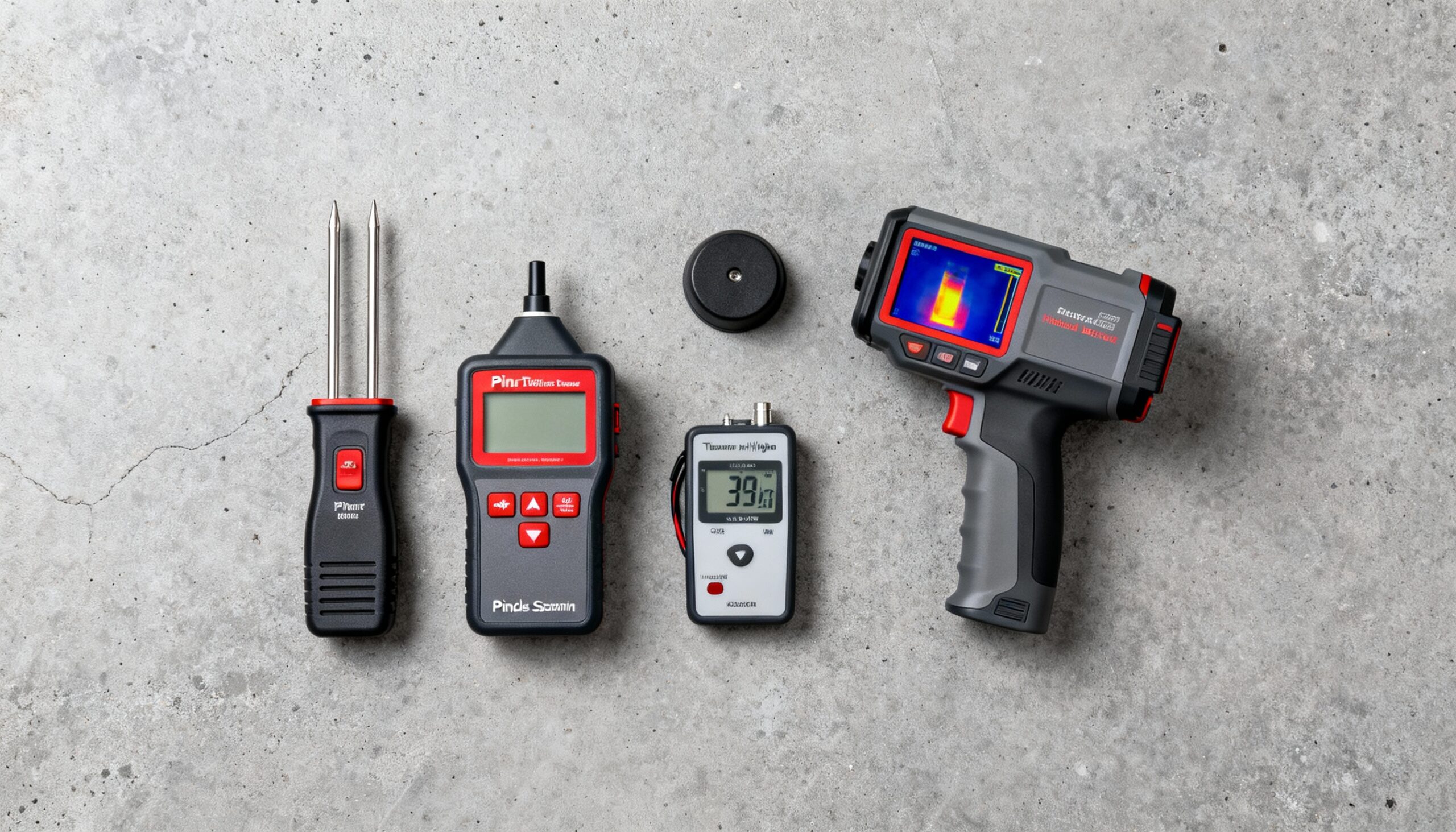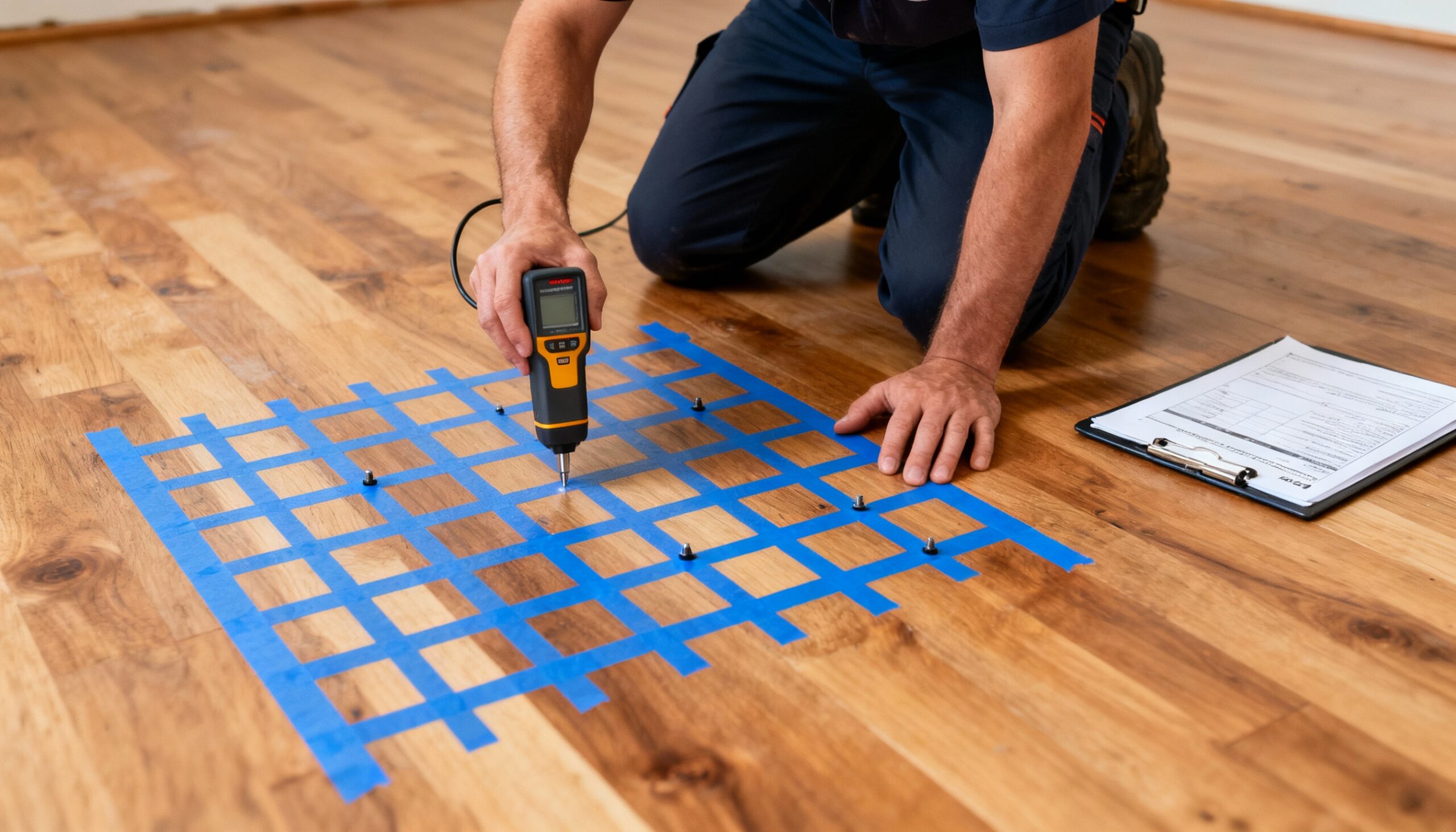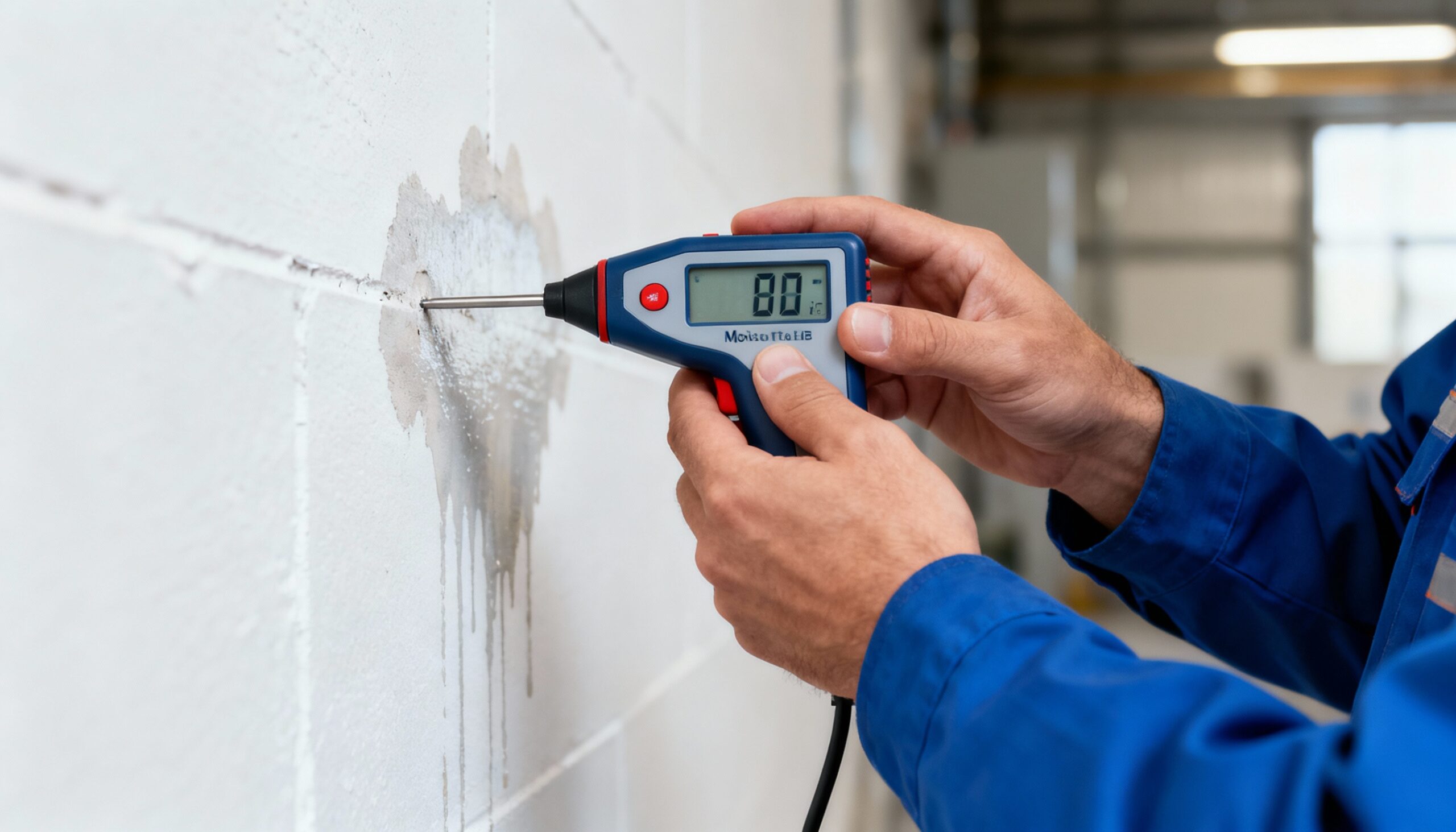The Science Behind Moisture Detection
Moisture meter readings rely on fundamental electromagnetic principles to quantify water content within building materials. Understanding these principles enables technicians to select appropriate equipment, interpret results accurately, and recognize measurement limitations.
Electrical Resistance Technology
Pin-type moisture meters operate on the principle that water conducts electricity. When two metal probes penetrate a material, the meter measures electrical resistance between the probes. Pure water conducts electricity efficiently, so higher moisture content produces lower resistance readings. The meter converts this resistance measurement into a moisture percentage through calibrated algorithms.
Key Formula:
MC = f(R) where R = V/I
Where:
MC = Moisture content (%)
R = Electrical resistance (ohms)
V = Applied voltage
I = Current flow between pins
This technology provides actual moisture content readings when properly calibrated to specific material species. Wood moisture meters, for instance, require species correction factors because different wood types exhibit varying electrical properties at equivalent moisture levels.
Electromagnetic Wave Technology
Pinless moisture meters utilize radio frequency or capacitance-based technology to assess moisture conditions without penetrating the material surface. These instruments generate electromagnetic fields that penetrate the substrate, measuring changes in field properties caused by moisture presence.
The dielectric constant of water (approximately 80) differs dramatically from most dry building materials (typically 2-5), enabling sensitive moisture detection through changes in capacitance or signal attenuation. This non-invasive approach proves essential when surface damage must be avoided or when scanning large areas for moisture mapping during commercial water damage assessment.
Moisture Meter Types and Applications
Professional moisture assessment tools fall into distinct categories, each optimized for specific applications and material types. Selecting appropriate moisture detection equipment depends on substrate characteristics, measurement objectives, and documentation requirements.
| Meter Type | Measurement Depth | Best Applications | Limitations |
|---|---|---|---|
| Pin-Type (Resistance) | Probe length dependent (typically 5/16″ to 3″) | Wood moisture content, drywall, insulation | Requires surface penetration, point measurements only |
| Pinless (Capacitance) | 3/4″ to 1-1/2″ typical | Screening, flooring evaluation, finished surfaces | Affected by surface conditions, requires flat contact |
| Pinless (RF) | Up to 1″ depending on frequency | Concrete, masonry, below-surface detection | Temperature sensitive, density variations affect readings |
| Thermo-Hygrometer | Surface and ambient conditions | Relative humidity, dew point, environmental monitoring | Indirect moisture measurement, influenced by air movement |
| Calcium Chloride Test | Surface emissions | Concrete slab moisture vapor emission | 72-hour test duration, measures emission rate only |

Pin-Type Moisture Meters
Resistance-based moisture meter readings provide the most accurate quantitative assessment of moisture content in wood and wood-based products. These instruments measure actual moisture percentage when properly calibrated, making them indispensable for documenting drying progress and determining restoration endpoints.
Professional-grade pin meters feature insulated probes that isolate readings to the probe tips, enabling depth profiling and gradient analysis. By taking moisture meter readings at multiple depths, technicians can identify moisture migration patterns and determine whether materials are drying from the surface inward or experiencing moisture wicking from hidden sources.
Extended-length probes and hammer electrodes expand assessment capabilities into structural members, wall cavities, and subfloor assemblies where standard probes cannot reach. This deep-penetration capability proves critical when investigating concealed moisture sources during mold remediation projects where hidden moisture sustains fungal growth.
Pinless Moisture Meters
Non-invasive moisture detection technology enables rapid screening of large surface areas without damaging finished materials. These instruments excel at identifying moisture anomalies beneath flooring, behind wall coverings, and within ceiling assemblies where penetration would cause unacceptable damage.
Capacitance-based pinless meters generate readings relative to dry conditions rather than absolute moisture percentages. Technicians establish baseline readings from known-dry reference areas, then compare suspect locations against this baseline. Readings elevated above the baseline indicate moisture presence, though the extent of elevation must be interpreted within the context of material type and thickness.
📊 Data Point: According to S500 professional standards, moisture detection readings should be documented using consistent measurement protocols, with reference materials and baseline comparisons noted for all non-invasive assessments.
Calibration and Accuracy Standards
Reliable moisture meter readings depend on proper calibration, appropriate settings, and understanding of measurement limitations. Professional moisture assessment tools require regular verification against known standards to ensure accuracy.
Wood Species Correction
Different wood species exhibit varying electrical properties at equivalent moisture levels, requiring species-specific correction factors for accurate readings. Professional meters include correction tables or built-in adjustments for common species groups.
| Species Group | Typical Correction Factor | Equilibrium MC at 40% RH | Common Applications |
|---|---|---|---|
| Douglas Fir | 0.00 | 7.7% | Structural framing, subflooring |
| Southern Yellow Pine | +0.5 to +1.0 | 8.0% | Framing, decking, pressure-treated lumber |
| Oak (Red/White) | +2.0 to +3.0 | 7.2% | Hardwood flooring, cabinets |
| Maple | +1.5 to +2.5 | 7.0% | Hardwood flooring, furniture |
| OSB/Particle Board | Variable | 8-10% | Sheathing, subflooring |
Temperature Compensation
Electrical resistance varies with temperature, affecting moisture meter readings in field conditions. Quality instruments include automatic temperature compensation (ATC) that adjusts readings based on ambient or material temperature.
Temperature Correction Formula:
MC(corrected) = MC(measured) + [T(actual) – T(reference)] × 0.05
Where standard reference temperature = 70°F (21°C)
For every 10°F deviation from reference temperature, uncorrected readings may shift by approximately 0.5% moisture content. This variation becomes significant when documenting drying progress or comparing readings taken under different environmental conditions.
Interpreting Moisture Meter Readings
Converting raw moisture meter readings into actionable restoration decisions requires understanding material-specific thresholds, environmental equilibrium concepts, and the relationship between moisture content and damage potential.
Dry Standard Determination
Establishing appropriate dry standards represents a critical step in moisture assessment. The dry standard defines the target moisture content for restoration completion and varies based on material type, geographic location, building use, and ambient conditions.
Professional standards recognize three approaches for establishing dry targets:
The pre-loss condition method uses unaffected materials from the same structure as reference points, assuming similar materials installed simultaneously reached equilibrium with the local environment. This approach accommodates regional humidity variations and building-specific conditions.
The equilibrium moisture content (EMC) method calculates the theoretical moisture content at which materials will stabilize under prevailing temperature and humidity conditions. This calculation-based approach provides scientifically defensible targets independent of reference materials.
EMC Approximation Formula:
EMC = (RH/100) × 0.3 × Material Factor
For wood at 50% RH and 70°F, EMC ≈ 9%
The manufacturer specification method applies to finish materials with specific moisture requirements, such as hardwood flooring that typically requires subfloor moisture content below 12% (or within 2-4% of the flooring material itself) prior to installation.
Drying Progress Documentation
Serial moisture meter readings tracked over time demonstrate drying progress and verify equipment effectiveness. Professional documentation includes measurement locations, times, ambient conditions, and equipment settings to create defensible records.
Drying curves plotted from sequential readings reveal patterns indicating normal progress, stalled drying, or moisture source identification needs. A typical drying curve shows rapid initial moisture loss followed by progressively slower drying as materials approach equilibrium.
🔬 Technical Note: When moisture meter readings plateau before reaching dry standard, the condition typically indicates insufficient airflow, inadequate dehumidification capacity, or continued moisture introduction from unidentified sources requiring additional investigation.
Advanced Moisture Assessment Techniques
Beyond basic moisture meter readings, advanced techniques enhance moisture detection capabilities and provide comprehensive assessment data for complex restoration scenarios.
Moisture Mapping
Systematic grid-pattern moisture detection creates detailed maps showing moisture distribution across affected areas. These maps guide equipment placement, identify moisture migration patterns, and document restoration progress visually.
Professional moisture mapping protocols establish consistent grid spacing (typically 12″ to 24″ centers), document measurement locations using room reference points or coordinate systems, and maintain consistent instrument settings throughout the mapping process. The resulting data enables calculation of affected square footage and optimization of drying equipment placement for projects requiring comprehensive remediation services.

In-Situ Relative Humidity Testing
For concrete slabs and assemblies where surface readings may not represent internal conditions, in-situ relative humidity testing provides accurate assessment of moisture conditions at specific depths. This technique places calibrated humidity sensors in drilled holes, allowing equilibration with the surrounding concrete before reading.
Standard F2170 specifies protocols for in-situ testing, including hole depth requirements (40% of slab thickness for single-side drying, 20% for double-side drying), equilibration periods (minimum 72 hours), and documentation requirements. This water measurement approach proves essential when evaluating concrete moisture conditions prior to flooring installation.
Industry Trends and Emerging Technologies
Moisture detection technology continues evolving, with innovations improving accuracy, efficiency, and data integration capabilities for restoration professionals.
Wireless Monitoring Systems
IoT-enabled moisture sensors provide continuous monitoring with cloud-based data logging, eliminating manual reading requirements and capturing moisture trends throughout the drying process. These systems alert technicians to anomalies, verify equipment operation remotely, and generate comprehensive documentation automatically.
Thermal Imaging Integration
Infrared cameras identify moisture-related temperature anomalies through evaporative cooling effects. While not direct moisture measurement, thermal imaging rapidly identifies areas requiring further investigation with quantitative moisture assessment tools. The combination of thermal scanning and targeted moisture meter readings maximizes assessment efficiency while minimizing invasive testing.
AI-Assisted Analysis
Machine learning algorithms analyzing moisture meter readings, environmental data, and drying curves can predict restoration timelines, optimize equipment deployment, and identify patterns indicating hidden moisture sources. These analytical tools enhance decision-making for complex commercial projects requiring multi-phase restoration approaches.
Frequently Asked Questions
What moisture meter reading indicates water damage in drywall?
Drywall moisture meter readings above 1% typically indicate elevated moisture conditions, while readings exceeding 2% suggest active water damage requiring remediation. Normal equilibrium moisture content for gypsum board ranges from 0.3% to 0.5% in typical indoor environments. Always compare readings against unaffected reference areas within the same structure.
How deep do pinless moisture meters measure?
Most pinless moisture detection instruments measure 3/4″ to 1-1/2″ below the surface, though exact depth varies by frequency, material density, and instrument design. Higher frequency sensors provide shallower but more precise readings, while lower frequencies penetrate deeper with reduced resolution. Consult manufacturer specifications for your specific moisture assessment tools.
Why do moisture meter readings differ between pin and pinless meters?
Pin-type meters measure resistance at probe tip locations, providing point-specific readings, while pinless meters average moisture conditions across the electromagnetic field zone. Additionally, pinless instruments display relative values requiring baseline comparison, whereas properly calibrated pin meters read actual moisture percentage. Both moisture detection methods have valid applications when used appropriately.
What affects moisture meter accuracy in concrete?
Concrete moisture meter readings are affected by aggregate type, admixtures, carbonation levels, reinforcement presence, surface treatments, and temperature. Surface moisture meters cannot accurately measure concrete moisture content directly; they indicate relative wetness only. For accurate concrete water measurement, utilize in-situ relative humidity testing per Standard F2170 protocols.
How often should moisture meters be calibrated?
Professional moisture assessment tools should be verified against calibration standards before each project and recalibrated annually by the manufacturer or authorized service center. Field verification uses moisture content reference blocks with known values. Document all calibration activities, including verification readings, dates, and any adjustments made to maintain defensible documentation.
What moisture content indicates adequate drying for hardwood floor installation?
Hardwood flooring manufacturers typically require wood subfloor moisture content below 12% and concrete slab relative humidity below 75%. Additionally, the moisture differential between subfloor and flooring material should not exceed 2-4%. These thresholds prevent post-installation problems including cupping, crowning, and adhesive failure. Always verify specific manufacturer requirements.

